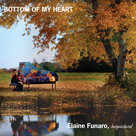

Elaine Funaro: Bottom of My Heart
Alienor Records
If you're thinking the harpsichord's best days are behind it, Elaine Funaro is here to enlighten you otherwise. The keyboard's modern-day relevance is attested to by the encompassing collection Bottom of My Heart, which presents a sprawling set of contemporary works written for the instrument by a large circle of composers. In terms of compositional content, it's a release whose focus is today, not yesterday.
As an ambassador for the instrument, Funaro cuts a striking figure as she performs in colourful attire on her custom-made contemporary harpsichord, the Kingston Opus #333, which, built by Richard Kingston, is adorned by artwork by North Carolina artist Lisa Creed. Aptly issued on Alienor Records, the contents derive from the Alienor Harpsichord Composition Competition that debuted in 1982 and with which Funaro has been associated for years. As the non-profit organization's Artistic Director, she has overseen numerous competitions and the presentation of countless scores; it has facilitated the creation of over 700 pieces from around the world and been instrumental in creating a vast contemporary repertoire for harpsichordists to draw upon.
Bottom of My Heart features thirty-three tracks, most of them standalones. Multi-part works by Dan Locklair and Ivar Lunde Jr.—the six-movement The Breakers Pound and the three-part Insectum Communis, respectively—are bookends to pieces by Andrew Gustar, Pablo Escande, Gianandrea Pauletta, Andrew Collett, and many others. The collection includes works that were presented at multiple competitions (eight to date), from the first in 1982 to ones in 2008, 2012, and 2015. In a number of cases, a competition theme provided creative direction, such that for 2008's gathering composers were instructed to use Couperin's L'art de toucher le clavecin as inspiration. Whereas Bartok's Mikrokosmos served as the inspiration for 2012's competition, 2015's eschewed a particular theme.
In addition to the variety on offer, what perhaps surprises even more is the stylistic range of pieces that push boldly beyond the parameters of pure classical music. The pieces are as much songs as formal compositions, with their brevity—most tracks are one to three minutes long—aligning them to popular music genres. The Breakers Pound is representative of the collection in its broad mix of moods and styles. After the brilliant sound of Funaro's harpsichord distinguishes the regal “Prelude,” the enigmatic “Waltz” injects the work with a creeping spidery quality—one can almost picture the insect's long legs climbing across a web as the music plays. True to its title, “Rag” swings like some early twentieth-century riff on blues and jazz, the endearing tune as far removed from Bach as might be imagined. A dramatic, stern-faced “Pavane,” energized “Galliard,” and aggressively churning “Postlude” round out the work. Even bluesier than “Rag” is Peter Klausmeyer's rollicking Pete Johnson's Ground. Sebastian Petak powers both Industry and Gears with motorik thrust, while Philip Underwood's jaunty Les Rejouissance beguiles with its cheeky strut and sunny disposition, as does Glenn Spring's Teasing Song (his Dirge is considerably sombre by comparison, naturally). Like Locklair's, Lunde Jr.'s piece ranges widely during its three Insectum Communis parts, from the stately “Papilionis” to the declamatory “Blatta.”
Like raindrops splattering against a window, Edward Gerber's and then they are gone comes and goes in the blink of an eye. Adam Rothenberg's Tamborin Vivace, on the other hand, lurches like some mythological behemoth decimating a landscape. The three excerpts from Sviatoslav Krutykov's irreverently titled Little Monkey Ten Snapshots are worth a listen too, as is Daniel Basford's delightful Pudu in the Forest. Presumably a product of the 2008 competition, Kent Holliday's Couperiniana 1 sparkles ravishingly; one similarly guesses that his two Mikrokosmicals miniatures were created for the Bartok competition. Some pieces do somewhat align themselves to the classical harpsichord tradition, Rudy Davenport's Passion, Ronald McKean's Water, and Rudy Davenport's two Bagatelles cases in point.
There are many takeaways from the album, but certainly one that must be noted is how good a time Funaro seems to have performing the material. She digs into pieces like Pete Johnson's Ground and Ivan Bozicevic's two Microgrooves settings with audible delight. The harpsichord has never had a better advocate than Funaro, who not only performs and records contemporary material written for the instrument but has also assumed curatorial responsibility for the publication of the Alienor-produced works. With her in place, it's impossible to imagine the instrument falling into disuse and being regarded as an instrument of no contemporary relevance.May 2025